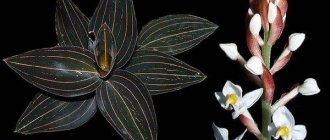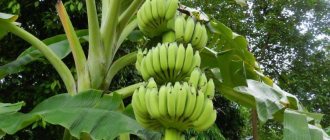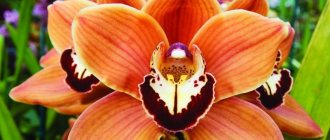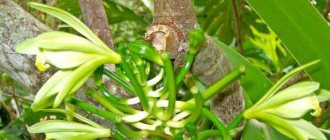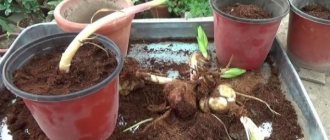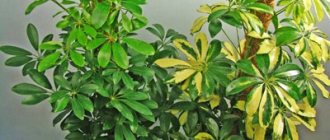Cymbidium aloifolium
Cymbidium aloifolium
The species is distributed in South Central China, Assam, Bangladesh, eastern Himalayas, India, Nepal, Sri Lanka, Andaman Islands, Myanmar, Thailand, Laos, Cambodia, Vietnam, Malaysia, Java and Sumatra, in evergreen, semi-deciduous and deciduous forests and savannah woodlands at altitudes up to 1100 meters above sea level.
They grow as epiphytes or lithophytes on open mossy rocks.
Hybrid variety is miniature, up to 30 cm in height. The flower has a yellow center and a purple stripe running along the petals.
In the wild, the stem of cymbidium reaches 1.5 meters.
Escape of sympodial type. Pseudobulbs are poorly developed, ovoid, 1.5-2.5 × 1-1.5 cm, completely hidden by sheaths of 3-4 (up to 6) leaves. The roots are fleshy and long.
Inflorescences are basal, vertical, 15-67 cm long, 3-9 (less often 13) flower racemes.
The flowers do not fade for 2-3 weeks, are strongly and pleasantly fragrant, 3-5 cm in diameter.
Petals and sepals are straw-yellow with green with 5-7 varying degrees of pronounced longitudinal veins of red or red-brown color.
The petals often have red-brown spots and the central vein is more pronounced.
The lip is pale yellow, green, sometimes white with red-brown veins and spots.
Possible mistakes in growing white flowers
There are several common mistakes that beginners encounter. As a result, the flower gradually dies if its care does not change.
- Lack of fertilizing and replanting. When the soil becomes depleted, the crop gradually slows down and begins to wither.
- Excess moisture. Because of this, the roots begin to rot. They can only be helped by physically removing traces of rot and replanting them in another pot.
- Using an opaque pot or the wrong soil. All this leads to the death of culture.
- Ventilate the room without protecting the orchid. The leaves turn yellow and fall off.
You need to properly care for your cymbidium orchid. It reacts quickly to any mistakes and begins to actively fade. No need to guess what the problem is. It is better to read the rules of care and compare them with actual actions. This will quickly resolve the problem.
5/5 — (1 vote)
Cymbidium eburneum
Cymbidium eburneum
The species is native to China and Myanmar.
Eburneum is also known as “Ivory”, which is associated with the special cream color of the buds. It has large flowers (up to 12 cm in diameter).
Peduncles reach 30 cm in height. The plant has narrow leaves of a rich green hue.
Thick bulbs have a stem-like shape.
The smell of the flower is reminiscent of lilac.
Cymbidium lancifolium
Cymbidium lancifolium
Cymbidium lancifolium is the most common species in nature. Most often found in India or China.
The plant is low, the leaves reach about 30 cm in length. The inflorescence is approximately the same; up to eight flowers with a diameter of 2.5 to 5 cm can be seen on it.
The center of each petal is marked with a bright pink or purple vein. The leaves are thin and pointed.
The variety is famous for its fragrant flowers.
In greenhouses it blooms in March or early April for a long time, up to several weeks in a row.
In nature, in the southern regions of its growth, this type of orchid can bloom almost all year round.
Diseases and pests
All Cymbidium diseases occur from improper care.
Excessive watering and low temperatures contribute to the appearance of root rot, anthracnose, gray rot, and sooty fungus. This can only be eliminated by completely replacing the soil and mandatory treatment of the roots with crushed coal.
High temperatures and dry air can cause the appearance of various pests. These are aphids, spider mites, mealybugs. Here, fungicides should be used to help the plant. In this case, all neighboring plants are treated.
If you become the happy owner of this type of orchid, provide the new plant with good lighting, regular watering, high air humidity and the required temperature. And your plant will delight you with abundant flowering and lush greenery.
Cymbidium dayanum
Cymbidium dayanum
The species got its name in honor of the British orchid collector John Day, who created a large number of drawings of these plants.
The species is widespread in Sikkim and northeast India, Myanmar, Thailand, Cambodia, Laos, Vietnam, China, Taiwan, Japan, the Ryukyu Islands, Malaysia, Sumatra, Borneo, Celebes and the Philippines.
In Thailand, this orchid is found in the north in mountainous regions at an altitude of 1100–1500 m, and in the east and southeast at an altitude of 800–1200 m.
In Malaysia it can be found in many places at an altitude of 150–1200 m. In China it grows on trees in open forests or on the slopes of gorges at an altitude of 300–1600 m.
In Sumatra it can be found on the lower branches of trees or on steep slopes. In the Philippines, this species grows in the ground, but can sometimes be found in tree hollows at altitudes of 300–1800 m.
Large sympodial epiphyte or terrestrial orchid with dense herbaceous growths.
Pseudobulbs are 2–5 cm long and 1.5–2.5 cm wide. They are quite small, spindle-shaped or ovoid, covered with leaf bases that overlap each other.
The pseudobulb can have from 4 to 12 leaves arranged in two rows. They are curved, narrow, thin, with pointed tops. The leaves are usually 30–60 cm long, but can sometimes reach 100 cm.
The peduncle reaches a length of 30 cm. At first it grows straight, but then bends and hangs down. The flowers are 6 cm in diameter, collected in a rather loose cluster.
The buds are small, have an elongated shape, the center of each petal is crossed by a wide burgundy stripe. The central part is a tucked lip, painted white.
Flowering begins in August and ends in December. The orchid prefers a climate close to subtropical.
Care
Cymbidium has a large number of subspecies, but caring for all of them is not particularly different from each other. This type of orchid is considered to be the easiest to care for , although it may be difficult for a beginner to grow a healthy plant with little experience in floriculture.
Substrate selection
For cymbidium, you can immediately purchase a ready-made soil mixture at a flower shop.
Typically, the packaging with such a substrate is already marked “For cymbidium and other terrestrial orchids.” More experienced gardeners can prepare the soil mixture themselves.
For cooking it is taken:
- crushed tree bark (it is best to choose coniferous trees);
- sphagnum moss;
- sand;
- charcoal;
- leaf fertilizer;
- perlite
All components are taken in the ratio 3:2:1:1:1:1.
Important! If the temperature in the room with the flower exceeds the required level, then the amount of moss in the soil must be increased several times.
Do not forget that before filling in the soil mixture, you need to place a drainage layer of granite stones, broken shards or expanded clay on the bottom of the planting container. The drainage system is a prerequisite for normal growth and development of epiphytes .
Choosing a pot
Cymbidiums like cramped pots best. The rhizome of the flower should not reach the walls of the container (there should be approximately 2-3 cm to the walls and 5 cm to the bottom). It is best to give preference to transparent planting containers, since these orchids need a lot of light.
You can purchase a ready-made transparent container for orchids with drainage holes already made in a special store.
In principle, you can plant an orchid in a clay pot, but you must understand that the plant will stick its roots to the walls of the container and you will have to break the pot so as not to damage the cymbidium rhizome.
Illumination
Cymbidium belongs to the category of the most light-loving epiphytes . Therefore, it is best to keep it on windows on the south side of the house. In summer, when the sun is most aggressive, you can move the container with the plant to a western or eastern window.
If you decide to leave the flower on the south side, then provide it with shade to avoid burns and overheating.
With a lack of light, the orchid's leaves will drop and the flower stalks will begin to dry out and fall off.
Temperature
Despite such an increased love for light, cymbidium does not like heat too much .
In winter, +10-15 degrees indoors will be enough for him, and in summer 18-25 degrees.
In summer, you can move the orchid to the garden or gazebo outside. But keep in mind that sudden temperature changes between day and night temperatures will negatively affect the condition of the flower.
How to water?
- During the warm season (spring and summer), you need to keep the substrate in the container with the orchid moist. Be careful not to let it dry out. For watering, use soft water at room temperature. Excess liquid remaining in the pan after watering must be drained immediately.
- In winter, watering is reduced several times, but they continue to carefully ensure that the soil does not dry out too much. You cannot overdo it with soil moisture, since dampness will lead to the onset of rotting of the rhizome and, accordingly, the death of the plant.
Important! A warm shower has a positive effect on the condition of cymbidium, but after it it is necessary to remove excess moisture from the surface of the plant. This should be done with cotton wool or a soft cloth.
Air humidity
The air humidity level in a room with cymbidium should always exceed the average (at least 60%). To provide the plant with this level of humidity, you need to use special equipment, for example, air humidifiers. If you do not have the opportunity to purchase such a unit, then simply place the container with the flower on a pallet with wet expanded clay.
In the hot season (spring and summer), you need to spray the orchid at least three times a day. If the humidity in the room is not high enough, then you may soon notice how the tips of the leaves of the cymbidium begin to dry out and the flower stalks begin to fall off.
Overwatering is also fraught with problems with the orchid. It may start to rot. So do not forget to ventilate the room with the flower (but do not leave it in a draft or open sun).
Spraying
During the period of intensive growth from March to September, cymbidium needs daily spraying with soft, warm water. In winter, spraying is stopped. To increase the humidity level in winter, small containers of water are placed next to the plant.
Feeding and fertilizer
Caring for cymbidium at home is carried out using fertilizers. They are applied from March to September once every 2 weeks. When choosing fertilizers, preference is given to organo-mineral complexes designed specifically for orchids.
Trimming
Cymbidium does not need special pruning. During the growing process, only damaged and dried leaves are removed from the plant.
Rest period
Cymbidium's dormant period lasts from October to February. At this time, it needs a low temperature of no more than +15°. An orchid will form a sufficient number of flower buds only if this condition is met. During the dormant period, the intensity of watering is significantly reduced. The orchid is watered no more than once a month.
Cymbidium propagation
This large and spectacular orchid, growing in dense groups, is propagated at home in only one way - by dividing the bush, carefully separating part of the pseudobulbs with good roots and planting them as independent plants. When dividing, at least one old pseudobulb is left in each part. After dividing the cymbidium orchid, care at home should be similar to care after transplantation.
Cymbidium tracyanum
Cymbidium tracyanum
In nature, Cymbidium tracyanum is found in Southeast China, Northern Thailand and Myanmar.
It grows epiphytically on trees, lithophytically on rocks and even directly on the ground at an altitude of 1200 to 1900 meters above sea level.
The pseudobulbs are oval, divided into 6-7 segments, about 12 cm in length, and grow very closely to each other.
A distinctive feature of the color is the lip with wavy edges of a cream color with red splashes.
Large yellowish-green flowers with small purple spots along the edges sometimes reach 15–20 cm in diameter.
The flowers are fragrant (smell of cardamom).
The front of the cream lip is also spotted. Its edges are wavy or fringed. Reaches a height of 1.2 m, in September at least 20 flowers appear on each brush.
The flowering period in greenhouses is from September to December, in nature it can last about a year.
Mr. Summer Resident explains: mistakes when caring for cymbidium orchids and their elimination
If a plant begins to lose its beautiful appearance, these are not always signs of disease or pest attack. Often the reason lies in care errors.
| Signs on leaves, etc. | Error | Solution |
| They turn yellow and wrinkle, and become covered with spots. | The room temperature is too high. | Adjust the temperature regime; Do not place the pot near radiators. |
| Sunburn. | Avoid direct sunlight on the foliage. Remove from the windowsill or provide shading. | |
| Root damage. | Remove the plant from the pot, cut off the rotten roots, treat it with charcoal, and replant it in a fresh substrate. Do not water for several days. | |
| Pseudobulbs turn yellow and rot. | Stagnation of moisture in the leaf axils after watering. | Trim the damaged areas, treat the wounds with charcoal, and let dry. Do not water for the next week. After watering and spraying, wipe the leaf sinuses so that no water remains in them. |
| They turn pale or yellow. | Poor or too much watering. | Adjust the watering regime, observing the condition of the substrate. |
| Lack of light. | Provide bright, indirect lighting for at least 12 hours a day. If necessary, use phytolamps. | |
| Lack of nutrients. | Apply fertilizers with every second watering, excluding the flowering period. | |
| Natural shedding of leaves. | From time to time, an orchid sheds old leaves - this is normal. | |
| The tips turn black. | Sunburn. | Avoid direct sunlight on the foliage. Remove from the windowsill or provide shading. |
| Too much watering. | Adjust the watering regime, observing the condition of the substrate. | |
| They curl up. | Sudden temperature change. | Do not take the flower outside during the cold season. |
| Lack of nutrients. | Apply potassium and magnesium fertilizers with every second watering, excluding the flowering period. |
Cymbidium lowianum
Cymbidium lowianum
In nature, it is found in India and in its homeland in Burma.
A large-flowered orchid with buds opening 20 cm or more. It has a thick meter-long peduncle. The leaves extend 0.75 m.
One inflorescence can contain up to 35 large flowers. The flowers are light green with a hint of yellow.
The lip has three dark crimson lobes, with a bright yellow stripe running along the edges of the middle lobe. On the front of the lip there is a scarlet spot in the shape of the Latin letter “V”.
The hybrid variety “Lilliput” grown on its basis is considered the most popular.
Cymbidium Lowe blooms in greenhouses from February to July. In nature, this period can last almost a year.
Cymbidium giganteum
Cymbidium giganteum
grows in the Himalayas. It is one of the largest epiphytes.
The bases of large peduncles are covered by leaves, their shape is closer to lanceolate, the edges are sharp. About 15 fragrant buds appear on one peduncle.
Yellow-green buds are covered with brown stripes. The lip is creamy, spotted and striped. The diameter of the buds is 12 cm, the length of the inflorescence is 0.6 m.
Blooms in November, fades in April. The flowers do not dry out for a long time, remaining fragrant and alive for 3-4 weeks.
The Red Chile variety is popular: the compact bush is decorated with deep red flowers.
Cymbidium pumilum
Cymbidium pumilum
is native to evergreen and deciduous forests of northern Vietnam and the Chinese province of Yunnan. It can also be found in Taiwan and Japan, where it was subsequently transported.
The plant is distinguished by the peculiarity that the petals change color from olive green to red after pollination.
The leaves of the plant are long, pointed, and appear in large numbers. One peduncle can bear up to eight flowers.
This variety combines compact plants with thin peduncles. The white lip contrasts with the red-brown petals. The flowers look like stars.
The buds open to 10-12 cm. It blooms in December.
Features of the variety
Cymbidium, like most orchids, is an epiphyte. That is, it lives on the crowns and trunks of trees. True, this requires that a large amount of humus accumulate between them. Hybrids also feel great on soft, damp tropical soil, but there are also representatives that grow even on rocks.
Plant development occurs due to the formation of new rosettes of leaves, in each of which, over time, a pseudobulb is formed in the center, which is the growth point of the orchid. The peduncle can be curved, straight, directed downward or to the side. There are flowers on it that live for several months.
Cymbidium ensifolium
Cymbidium ensifolium
is an unpretentious plant. The stem is erect, from 15 to 65 cm long. The peduncle contains up to 9 small buds, no more than 3-4 cm in diameter. The petals are pale yellow, each with burgundy veins.
The lip is pale yellow or light green, with dark coral stripes in the middle and brown stripes on the sides.
Based on the wild species, such hybrid varieties as Peter Pan, Lovely Melody and Golden Elf have been created.
Blooms all winter and most of spring.
Reproduction
This plant is not recommended to be propagated at will. That is, for example, when it blooms, lays buds, and is actively growing, there is no need to touch it . And also, you should not divide a young specimen that has not yet bloomed. Cymbidium is propagated in two ways: division and seeds.
By division
During the next transplant, the mini cymbidium is divided, leaving 3–4 bulbs on each part. There is no need to water for several days after planting.
The cuts must be dry. With further watering, water should not fall on the cuttings until new shoots appear. Next, standard care is required.
This video shows how to propagate cymbidium by dividing the bush.
Seeds
The process is quite troublesome and long. Glass containers with tight lids are sterilized. Then the so-called Knudson's decoction is prepared in a water bath .
It should become homogeneous with an acidity level of 4.8 - 5.2 pH. The finished broth is poured into special containers and sterilized in a steamer basket. They are kept in the cold for the next 3 to 5 months.
The seeds are kept in a lime solution for 10 minutes. Place a jar of solution in a pan of boiling water, open the lid and transfer the seeds into it. The flasks are stored at a temperature of + 20–22 degrees .
If after a couple of days there is no mucus or plaque, everything went fine.
Note! The leaves will appear first, and then the roots. The seedlings will grow in the jar next year. Then they are transplanted into the substrate.
Cymbidium insigne
Cymbidium insigne
A beautiful orchid with light or bright pink buds up to 8 cm in diameter.
The petals are spotted with red, and there are spots along the edges of the curved back front of the lip.
The stem reaches a height of 0.8 m. Each stem has from 9 to 15 inflorescences. Blooms in February.
What is the difference from other types?
There are several signs by which Cymbidium can be easily distinguished from other members of the family.
- Leaves. They are long, linear, pointed at the ends.
- The presence of a “lip”. This is nothing more than a growth in the sepal. Its peculiarity is its variegated color.
- Pseudobulb. This is the thickened part of the stem located at the very root. It is in them that the orchid accumulates moisture.
- Petals and sepals are the same in shape and color.
Reference . A leaf color that is too dark indicates that the plant is not receiving enough light.
Cymbidium Ice Cascade
Cymbidium Ice Cascade
grows naturally in Australia and Southeast Asia. It is an ampelous variety of cymbidium.
The flowers are white and small. There are up to 300 flowers in racemes. They bloom gradually.
The flowering period extends over many months. This feature, as well as the unpretentiousness of the plant, make it very popular among gardeners for home cultivation. The smell is pleasant.
How to propagate?
At home, cymbidium can be propagated vegetatively (dividing the bush). It is important to remember that each division should contain several pseudobulbs and 2 - 3 young shoots .
- The plant is cleared of substrate.
- Cut the rhizome with a sharp knife and sprinkle the “wounds” with crushed activated carbon.
- After an hour, the divisions are planted in new pots.
Important! When replanting, the new pot should be 2 cm larger than the previous one.
Cymbidium Vogels Magic
Cymbidium
'Vogel's Magic' (Cymbidium Tethys x Cymbidium Vogelsang) – has a long and complex pedigree.
The variety owes its charm to the very interesting spotted color of the flowers, an unusual and complex shade.
The flowers are medium in size, beautifully shaped with a very showy lip.
Petals of various shades of pink with large dark purple spots. The lip is lighter, but the spots on it are larger.
The hybrid belongs to compact and miniature varieties with drooping, abundant inflorescences, which are desirable for home collections.
